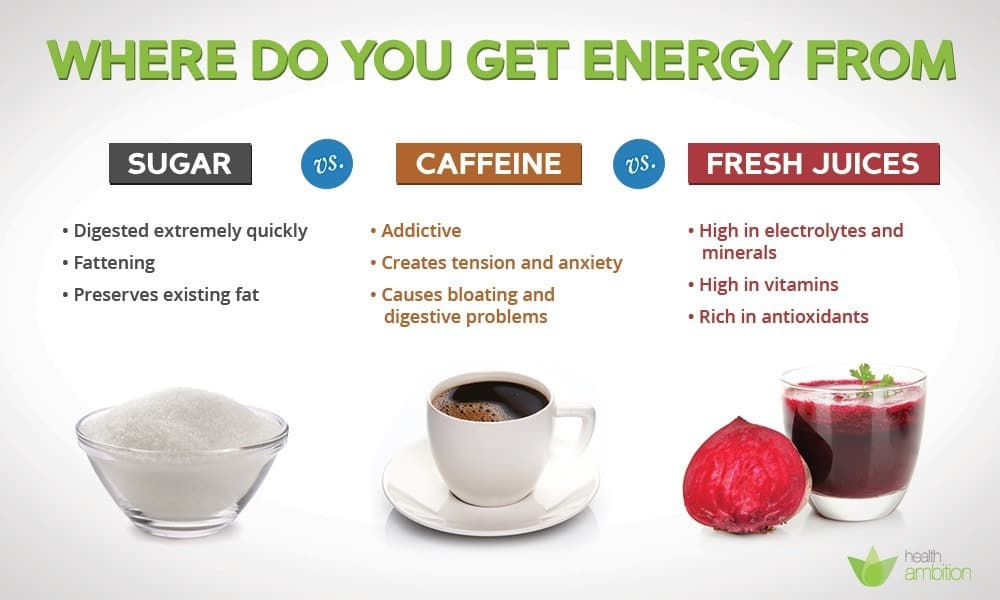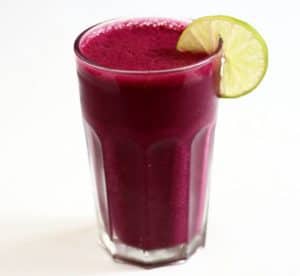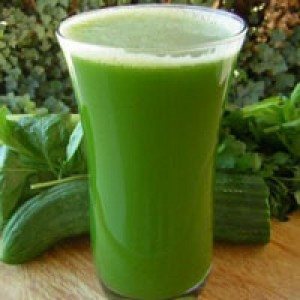
Your body needs much more than simple calories to produce strong and stable energy. Vitamins, minerals, enzymes and various other nutrients all have a vital role to play in energy production and a deficiency in any number of them can have a serious impact on how you feel.
Fresh vegetables and fruits are some of the best sources of the nutrition you need to perform at your best. But how do we fit enough of them into our diet? That’s where juicing comes in.
The unique nature of freshly made fruit and vegetable juices makes juicing especially effective, particularly for those that often find their energy levels low or fluctuating wildly due to the effects of sugar or caffeine.
Here’s why juicing is such a great source of energy for your body, especially compared to caffeine or sugar. Following this are five juicing recipes to power up your cells, improve your concentration and focus and enhance your overall vitality.
Here’s an interesting video for juicing for clear skin & plenty of energy!
Sugar, Caffeine or Fresh Juice – Which Is Better for Energy?
Sugar Energy
Many people start the day with sugary breakfast cereals or white bread (virtually equivalent to sugar to your body and possibly even worse). These simple and unnatural carbohydrates are digested extremely quickly and hit your bloodstream with large amounts of sugar in as little as 15 minutes.
You’ll often see processed cereals trumpeting on their packaging that they are a source of energy. But is this really the type of energy you want? You may feel a temporary burst, or even a little wired or high, but the effect is short-lived.
Simple sugar energy quickly overloads your bloodstream with far too much glucose for it to handle. In fact, it’s such a threat to your body’s health that it produces the hormone insulin to shuttle the excess sugar out of your bloodstream for storage.
Insulin is the fat storing hormone. It can store some of the excess sugar you’ve absorbed from the bread or cereal in your liver as glycogen. But once that’s full it can be converted to triglycerides and stored as body fat.
In removing the excess sugar from your bloodstream, insulin often does its job too well and leaves you with low blood sugar. So just a few hours after a concentrated simple carbohydrate meal, your energy is gone, you feel tired, sometimes lightheaded and usually hungry again.
To top it all off, insulin has been using that time to store more body fat and effectively prevent stored fat cells from being used as energy.
Caffeine Energy
Many more of us start the day with a shot of coffee and if you are addicted to caffeine it will usually make you feel better and more energized. It’s important to realize though that this is simply because it temporarily negates the effects of caffeine withdrawal, something millions of people in America go through every morning.
Research is showing that once you replace coffee with healthier alternatives and are no longer addicted to caffeine you perform better without it than you did when you needed it just to wake up.
Even in the medium-term, caffeine becomes less and less effective as a drug and you end up needing more and more to get the same buzz from it. For many people that ‘buzz’ has long since gone beyond a little extra energy and would be better described as tension and anxiety.
Coffee can also strip your body of important minerals like magnesium, increase acidity and potentially cause gastrointestinal problems like bloating, cramps and poor digestion. All of these regular side effects can have a seriously negative impact on your energy levels.
Fresh Juices for Energy
Freshly made juices are one of the simplest and best ways to improve your energy levels. This is because the nutrition in freshly juiced fruit and vegetables is very easily assimilated, energizes your cells and gives your body what it really needs to perform at its best.
Vegetables and fruit juices are concentrated sources of electrolyte minerals like magnesium, calcium, potassium and sodium, so important for metabolism, stable blood sugar levels, muscle and brain function and numerous cellular processes involved in energy production throughout your body.
Trace minerals like iron, manganese, selenium and zinc are also vital for creating and maintaining energy within your body and juicing a variety of produce is a great way to cover a lot of these nutritional bases.
Pro-vitamin A, vitamin C and B vitamins in particular are vital for stable mental and physical energy. When levels are low your body and brain will soon suffer but fresh juices are a simple way to increase your intake of natural and highly absorbable vitamins.
There are also a rich range of enzymes, antioxidants and other phytonutrients to be found in making up your own juices and the five recipes coming up next are great examples of how easy it is to improve your health with homemade juice.
If you want to increase your energy levels and improve your overall vitality then juicing offers a concentrated and effective way to give your body the nutrition it needs.

Juicing Instructions
With the five recipes ahead and any other juices you’d like to make up there are a few simple factors to keep in mind:
- Organic produce is preferred where possible, particularly with carrots, celery, cucumber, apples, berries and greens.
- If you can’t find organic then wash and scrub your fruit and veggies in warm water and a splash of apple cider vinegar to minimize waxes and sprays.
- It’s recommended to add the juice of a lemon or lime and a couple of ice cubes to the collection container of your juicer before you start juicing. This minimizes oxidization and improves the nutrient retention of your juice.
- Once your produce is washed and chopped to fit through the juicer feed, simply started up your juicer and steadily push it all through. It’s best to alternate soft and then hard, such as tomatoes followed by carrots, to minimize heat and get the most juice into your cup.
- As soon as it’s done, stir it up and drink immediately for the best taste and most health benefits. While lemon juice will give you a little longer, freshly made juices are meant to be enjoyed straight away.
Now onto the recipes.
5 Juice Recipes for Better Energy
The Power Veg

When to drink: Anytime
Best situations: Before or after exercise
Tastes: Slightly sweet and strong
Carrots are a high vitamin, mineral and antioxidant vegetable and perfect for juicing, while celery is particularly hydrating and alkalising for proper cellular communication.
Beets are also rich in energising minerals and special phytonutrients that cleanse the liver and the blood. As an optional, but highly recommended final ingredient, fresh ginger’s volatile oils give this juice a noticeable energy kick.
Ingredients
- 3 medium carrots.
- 2 stalks of celery.
- 1 large or 2 small beets.
- Around an inch-long piece of ginger, a bit more if you like the fiery taste.
Preparation
- Clean all veggies
- Cut into 1 in. chunks (cut beets slightly smaller)
- Juice all ingredients, stir, and drink immediately
(serves 2)
Healthy fact: Ginger is great for the digestive system. It has been shown to reduce nausea, motion sickness, and even flatulence.
The ReVITAlizer

When to drink: Morning and Afternoon
Best situations: Whenever you’re in need of an energy boost
Tastes: Rich and frothy, slightly sweet
Lycopene rich tomatoes are great for juicing and cucumber is extremely hydrating, energizing and surprisingly healthy.
Apples add sweetness and many antioxidants, while kale is one of nature’s most powerful green foods and an exceptional natural multivitamin.
This juice recipe provides many nutritional elements and is a great pick me up after a long day at the office.
Ingredients
- 2 large tomatoes
- 1 large cucumber
- 2 apples
- 2 branches of kale
Preparation
- Thoroughly wash all produce
- Slice apple, tomato, and cucumber into chunks (may or may not be necessary, depending on your juicer)
- Juice everything, stir your juice, and drink immediately
(serves 2)
Healthy fact: Kale, the so-called “Queen of Greens” has been steadily gaining popularity in recent years due to its antioxidant and cholesterol-reducing properties.
The Odd Couple Cure

When to drink: Afternoon and evening
Best situations: To complement a nice meal
Tastes: Sweet, but not too strong
You may not think these ingredients would go well together, but this seems to be one of those pleasant juicing surprises that results from experimentation.
Pineapple is a good source of vitamin C and uniquely the digestive enzyme bromelain, while parsley is an intensely cleansing juicing ingredient and highly beneficial for your kidneys and liver.
Cabbage juice is excellent for your whole gastrointestinal tract and particularly for preventing ulcers in your stomach. Adding delicious apples along with the pineapple to this recipe overpowers the parsley and cabbage and you shouldn’t taste them too much.
Ingredients
- Half a small pineapple.
- 1 bunch of parsley.
- Half ahead of cabbage.
- 2 apples.
Preparation
- Clean all produce thoroughly
- Put each ingredient through the juicer (you can juice the rind of the pineapple as well – it includes many of its nutritious properties!)
- Stir and drink your juice immediately
(serves 2)
Healthy fact: Aside from Vitamin C and bromelain, pineapples also include a mineral called manganese, which helps strengthen your bones!
The Sweet Mint Finisher

When to drink: Anytime after eating
Best situations: As a way to wash down and help digest a meal
Tastes: Sweet and minty
Papayas are a high antioxidant fruit that also contain a digestive enzyme called papain. This enzyme aids in breaking down troublesome undigested proteins in your body that can negatively affect your energy levels.
Strawberries taste great juiced and are rich in vitamin C. The nutrients in them also improves your body’s response to oxidative stress and enhances red blood cell production. In addition, the powerful volatile oils in fresh mint improve digestion and give this juice an energizing finish.
Ingredients
- Half a large papaya.
- A cup of strawberries.
- A handful of fresh mint, including the stalks.
Preparation
- Wash all produce thoroughly
- Cut papaya into chunks, and slice the stems off the strawberries
- Juice all ingredients and drink immediately
(serves 2)
Healthy fact: Mint has been used for thousands of years across the globe as a digestive tract relaxer. Its aroma alone activates digestive saliva and enzymes in the body that help break down food smoothly.
The Nutro-Tang

When to drink: Afternoon
Best situations: Relaxing on a hot day
Tastes: Sweet
Kiwi adds a nice tang to this juice and is a great source of vitamin C, while raspberries are a powerhouse of phytonutrients for better health and higher energy levels.
Watermelon is surprisingly good for high blood pressure and improving blood flow for natural relaxation. It is also a great tasting source of heart protecting lycopene and anti-inflammatory compounds.
This is a great juice recipe for summer and will really satisfy your thirst and quickly charge up your batteries when you’re tired. It’s well worth trying.
Ingredients
- 2 kiwifruit (no need to peel, just wash them).
- A cup of raspberries.
- As much watermelon as you can easily drink.
Preparation
- Wash your produce (scrub that watermelon skin!)
- Cut watermelon and kiwi into 1 in. chunks
- Put everything through the juicer
- Add ice, and drink cold
(serves 2)
Healthy fact: The skin of the kiwi is one of the only organic sources of omega-3 fatty acids (most commonly found in fish). The body needs these fatty acids and cannot produce them naturally.
Conclusion
Feel free to make up your own juicing recipes for energy. Experimentation is part of the fun and the more different fruits and vegetables you try the broader the range of energizing nutrients you’ll be delivering straight to your body’s cells.
If you’d like to have a really detailed manual on all the benefits of juicing, not just for elevating your energy levels, but also for enhancing the way you look, preventing diseases and improving your overall long-term health, then The Ultimate Juicing Guide is the best I’ve seen.
It has 50 juicing recipes, nutritional information for a wide variety of fruits and vegetables and step by step instructions on how to make them.
Have you tried juicing to improve your energy? If not I’d highly recommend two weeks of making up a fresh juice like one of these recipes once a day.
Morning, before lunch, mid-afternoon, when you get home from work, or whenever fits into your schedule is fine. The important part is to make it a habit. Most people are so happy with the difference it makes to their health and energy that they never look back.
I have a juicer but don’t use it every day. I will with these recipes
Brilliant easy receipes, thank you for sharing.